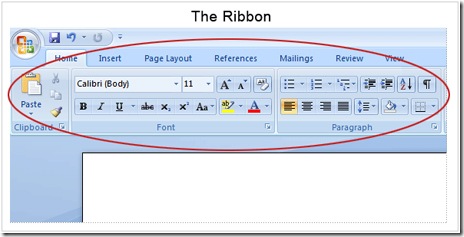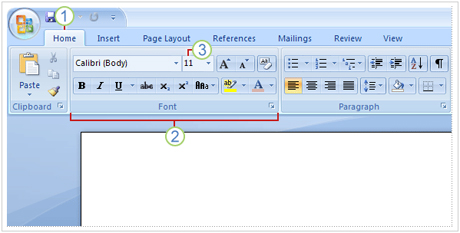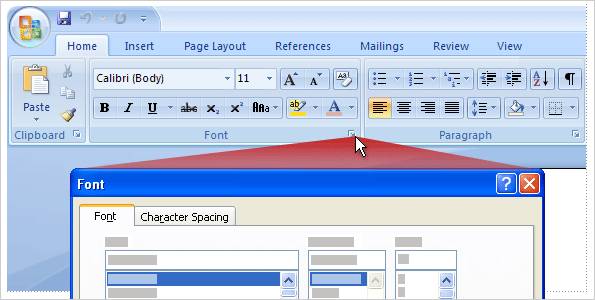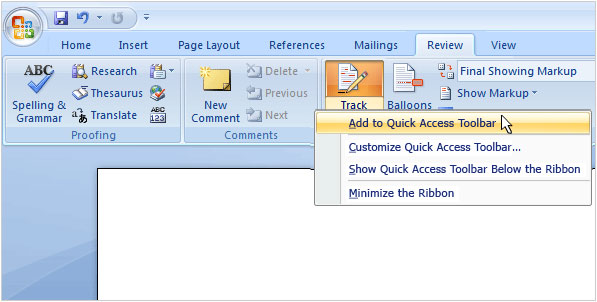Introducing New Interface of Microsft Word 2007
But the 2007 version has been much improved and brought more convenience and innovation. For ease of familiarization with the interface, we would like to give the specific instructions below

The Microsoft Word 2007 interface is thebiggest change of the main interface, the Ribbon or the menu bar contains command boxes for you to use and manipulate without having to search in a pile. Menu to find what you need.The Ribbon has been studied and designed so that orders are placed in the most reasonable positions.
On the Ribbon there are 7 Tabs (tags):
-Home:Includes text formatting tools such as: Font, paragraph, copy, paste, Bullets and numbering… .
-Insert:Allows insert objects into the text such as: insert Picture, WordArt, Equation, Symbol, Chart, Table, Header and footer, Page number, .
-Page Layout:Settings settings, format for paper such as: Page setup, Page Borders, Page Color, Paragraph, …… .
-Reference:Tools related text formatting such as: Insert automatic indexing captions, .
-Maillings: Mail merge toolbar.
-Review: Check functions like grammar, spelling .
-View: Working with display screen.
In addition, MS.Word 2007 also has extra tabs, this tab will only appear on the Ribbon when you need them.
Or when you draw a table and need to edit on the table you have just set, click on the table => then on the Ribbon appears a new Tab Tools including Design and Layout.

There are three basic components on the Ribbon : it is helpful to know what each part is called and how to use it.
1. Tab (tab) has 7 basic Tab horizontally above, each Tab represents an area of activity.
2. Group (group) Each Tab consists of many Groups that gather closely related objects.
The buttons display the dialog boxes for each group in the Word 2007 interface

That arrow button is called Dialog Box Launcher (the button that opens the dialog box).If you click on that button it will open the options related to the respective group.These options appear as dialogs that you see in earlier versions of Word.
By the way, talking about previous versions of Word, you might be wondering if you can choose an interface like the previous versions in Word 2007.The answer is NO.However, once you are familiar with the new interface, you'll enjoy the convenience it offers.
Quick access toolbar in Word 2007
The Quick Access Toolbar is a small area located on the left corner of the Ribbon, it contains the commands you use day to day such as Save, Undo, Repeat.You can add the commands that you usually use so that they will always appear without knowing what the current Tab is.

Right-click the command button that you want to add to the Quick Access Toolbar, and select Add to Quick Access Toolbar.
Temporarily hide the Ribbon in Word 2007
The Ribbon makes everything in Word 2007 focused and easy to find what you need.However, sometimes you do not need to find anything.You just want to focus on working on your documents and you want more space.It's simple, let's temporarily hide the Ribbon.
How to hide the Ribbon: Double-click on the current Tab, the groups of Tabs will disappear.That way you have more space.
When you want the Ribbon to reappear, double-click the current Tab again.
 Some experience in Excel spreadsheets
Some experience in Excel spreadsheets FREQUENTLY ASKED QUESTIONS IN MS Word
FREQUENTLY ASKED QUESTIONS IN MS Word Common Shortcuts In Microsoft Office
Common Shortcuts In Microsoft Office Common Errors Occur In Excel Operations
Common Errors Occur In Excel Operations 16 Essential Tips In Excel
16 Essential Tips In Excel Basic MS word errors encountered in office computing.
Basic MS word errors encountered in office computing.